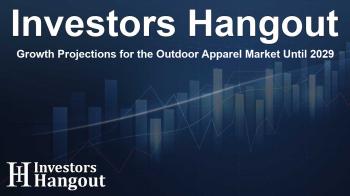Growth Projections for the Outdoor Apparel Market Until 2029

Understanding the Outdoor Apparel Market's Growth
The global outdoor apparel market is on the verge of significant expansion, estimated to grow by USD 7.30 billion from 2025 to 2029. This anticipated growth highlights the increasing demand for outdoor clothing and equipment, emphasizing the market's contribution to various leisure activities and sports. As more people embrace an active lifestyle, the market is set to expand at a compound annual growth rate (CAGR) of 6.4% during this timeframe. A deeper dive into market segmentation will reveal valuable insights regarding distribution channels and product types.
Market Segmentation Breakdown
Distribution Channels
The outdoor apparel market is segmented primarily into online and offline distribution channels. While the offline channel has seen a decline in revenue, the growing trend of online shopping has compelled vendors to adapt by enhancing their retail presence through specialty stores and local markets. Notably, Decathlon SA operates extensively, boasting nearly 1,700 retail locations in various countries. Retailers are strategizing to maintain competitiveness amidst increasing market competition by offering versatile pricing models and extensive product selections.
Product Types
Within the outdoor apparel market, product categories such as top wear, bottom wear, coveralls, and accessories are prevalent. Each category serves a different purpose, catering to varied consumer needs. For instance, consumers are increasingly drawn to high-quality garments that offer protection and functionality, especially in changing weather conditions. Advances in fabric technology, including moisture-wicking and waterproof materials, significantly benefit the product category, enhancing performance and comfort.
Regional Appeal and Consumer Preferences
Geographic Demand
Global demand for outdoor apparel varies across regions, including North America, Europe, APAC, South America, and the Middle East and Africa. Geographic factors play a critical role in shaping these preferences, with varying climates dictating the type of apparel required. As outdoor activities gain traction, the need for location-specific gear becomes increasingly important, leading brands to tailor their offerings accordingly.
Consumer Insights and Trends
In today's market, consumers prioritize not only durability and functionality but also style. The outdoor apparel industry has made strides in fabric innovation, providing clothing that is fashion-forward but also practical for outdoor adventures. Furthermore, children's outdoor apparel is witnessing a boom as parents seek to ensure safety without compromising comfort. The emphasis on quality, sustainability, and responsible sourcing resonates well with modern consumers, further driving market demand.
Environmental Considerations and Brand Responsibility
Awareness of Climate Change
Climate consciousness among consumers impacts purchase decisions, as many favor brands that align with eco-friendly practices. As a result, the outdoor apparel market has begun focusing on long-lasting products made from sustainable materials. Brands are committing to reducing waste, utilizing recycled fabrics, and exploring alternatives that cater to environmentally conscious consumers.
Advancements in Performance Wear
The development of performance wear is pivotal to the outdoor apparel market. With advancements in materials and design technologies, brands are creating innovative products that significantly improve user experiences. Enhanced breathability, insulative properties, and traction-integrated designs play critical roles in product appeal, thus contributing to the sector's projected growth.
Market Overview and Future Direction
The outdoor apparel market functions at the intersection of fashion, function, and environmental stewardship. From base layers to outerwear and accessories, the range of products available reflects a combination of style and utility aimed at improving consumer interaction with nature. The anticipated growth in this market is fueled by an increasing appetite for active lifestyles, the demand for high-performance clothing, and evolving consumer preferences toward sustainable practices. As the outdoor apparel industry adapts to these changes, brands focusing on technological advancements and consumer-centered design are poised to thrive in the upcoming years.
Frequently Asked Questions
1. What is the expected growth of the outdoor apparel market?
The outdoor apparel market is projected to grow by USD 7.30 billion from 2025 to 2029, with a CAGR of 6.4%.
2. What are the main distribution channels in this market?
The main distribution channels are online and offline, with a significant shift towards online shopping.
3. How are brands responding to environmental concerns?
Brands are adopting sustainable practices, focusing on high-quality, eco-friendly materials, and reducing waste.
4. What product categories are included in the outdoor apparel market?
Main categories include top wear, bottom wear, coveralls, and various accessories designed for outdoor activities.
5. How does climate change affect consumer choices?
Consumers are increasingly favoring brands that prioritize sustainability and responsible sourcing to mitigate climate impacts.
About Investors Hangout
Investors Hangout is a leading online stock forum for financial discussion and learning, offering a wide range of free tools and resources. It draws in traders of all levels, who exchange market knowledge, investigate trading tactics, and keep an eye on industry developments in real time. Featuring financial articles, stock message boards, quotes, charts, company profiles, and live news updates. Through cooperative learning and a wealth of informational resources, it helps users from novices creating their first portfolios to experts honing their techniques. Join Investors Hangout today: https://investorshangout.com/
Disclaimer: The content of this article is solely for general informational purposes only; it does not represent legal, financial, or investment advice. Investors Hangout does not offer financial advice; the author is not a licensed financial advisor. Consult a qualified advisor before making any financial or investment decisions based on this article. The author's interpretation of publicly available data shapes the opinions presented here; as a result, they should not be taken as advice to purchase, sell, or hold any securities mentioned or any other investments. The author does not guarantee the accuracy, completeness, or timeliness of any material, providing it "as is." Information and market conditions may change; past performance is not indicative of future outcomes. If any of the material offered here is inaccurate, please contact us for corrections.
